You'll need a precise temperature schedule to master outdoor meal success. Start by keeping cold foods below 40°F in insulated coolers and hot foods above 140°F using warming trays. Don't let food linger in the danger zone (41-135°F) for more than two hours, or one hour if it's over 90°F outside. Check temperatures every two hours and cook meats to specific internal temperatures: hamburgers at 155°F, poultry at 165°F, and fish at 145°F. Position your grill away from direct sunlight and use shade structures when possible. Following these temperature guidelines is just the beginning of your outdoor cooking mastery.
Morning Temperature Setup Points
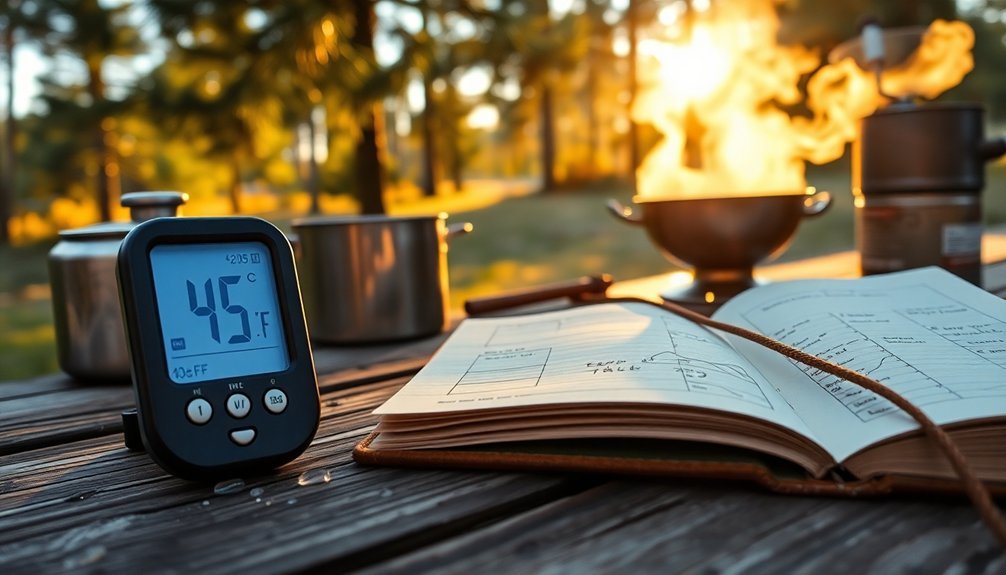
The morning setup for outdoor meal temperatures requires careful planning to maintain food safety.
You'll need to start by ensuring your cold foods stay below 40°F in insulated coolers with ice packs, while hot foods must remain above 140°F using warming trays or chafing dishes.
Before heading outdoors, you'll want to prep make-ahead items like chicken salad or breakfast foods and store them properly. Knowing the temperature danger zone between 41°F and 135°F helps you avoid dangerous bacterial growth.
Remember to check cold food temperatures every two hours and discard anything that exceeds 70°F.
For hot dishes, use a food thermometer to verify they've reached safe internal temperatures, particularly poultry at 165°F.
When serving, keep cold items in their coolers until needed, and maintain hot foods in warmers that can hold steady temperatures.
Label everything with dates and use clean utensils to prevent cross-contamination.
Midday Peak Heat Management
During peak midday hours, managing outdoor meal temperatures becomes especially challenging due to intense heat exposure.
You'll need to adapt your cooking and serving strategies to maintain food safety and comfort. Keep your outdoor cooking time brief by using quick methods like grilling or pan-frying, and opt for lighter, cooler dishes like salads and chilled soups.
Stay hydrated while preparing meals by drinking water regularly and consuming water-rich foods. Consider incorporating fresh fruits and vegetables into your outdoor meals for additional hydration benefits.
When you're cooking outdoors, wear light-colored, loose clothing and use sun protection. It's best to limit your cooking activities between 11am and 3pm – if you must cook during these hours, use a shaded area and guarantee proper ventilation.
Monitor weather forecasts and air quality to plan your outdoor meal prep accordingly, and consider using fans to maintain airflow around your cooking space.
Optimal Food Safety Checkpoints

Safe outdoor dining begins with a systematic approach to food handling and temperature control.
Using bristle-free brushes helps ensure no dangerous metal pieces contaminate your grilled foods.
You'll need to regularly check hot foods stay above 140°F and cold items remain below 40°F. Use your food thermometer to verify hamburgers reach 155°F, poultry hits 165°F, and fish cooks to 145°F.
Monitor your cooling process carefully: foods should drop from 135°F to 70°F within two hours, then reach 41°F in the next four hours.
During service, don't let food sit in the danger zone (40°F-140°F) for more than two hours, or one hour if it's over 90°F outside. Keep your coolers closed and shaded, using separate ones for raw meats.
When in doubt about a food's safety, throw it out – it's better to waste food than risk illness.
Essential Time Temperature Combinations
Maintaining precise temperature control during outdoor grilling guarantees your meats reach ideal doneness while staying food-safe. You'll need to monitor specific internal temperatures and cooking durations for different cuts and types of meat.
| Meat Type | Internal Temp | Grill Time |
|---|---|---|
| Steak (Medium Rare) | 130-140°F | ~2 min/side |
| Chicken Breast | 165°F | 5-7 min/side |
| Hamburger | 160°F | ~5 min/side |
| Whole Chicken | 180°F | 1-2 hours |
For steaks, you'll want high heat (450-650°F), adjusting time based on your preferred doneness. Chicken pieces require medium-high heat (400-450°F), while whole chickens need longer cooking at medium heat (350-375°F). Fish fillets are best cooked on medium high heat for optimal texture and flavor. Always use a meat thermometer in the thickest part to verify proper temperature, and remember that thickness affects cooking duration.
Solar Position Temperature Adjustments
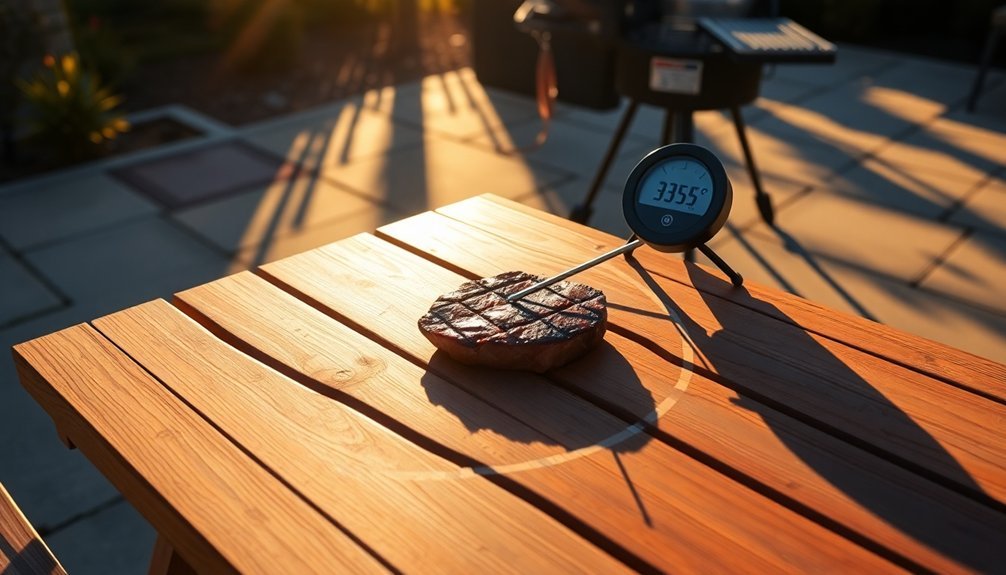
To achieve ideal cooking temperatures in your solar oven, proper positioning and regular adjustments are essential throughout the day. Place your oven in direct sunlight facing south, and you'll need to reposition it frequently to maintain peak sun exposure. For best results, aim for temperatures between 200°F and 300°F.
Your latitude and the season will determine how you'll need to tilt your oven. If you're in a northern location, you'll want to increase the tilt angle, especially during winter months.
Box cookers with compensated inclines work well for varying sun angles, while parabolic cookers need constant adjustment. To maintain heat efficiency, use dark pots with lids and avoid opening the oven frequently.
Remember to preheat for 30 minutes before cooking, and monitor the internal temperature with a thermometer.
Weather Impact Control Measures
When you're grilling on hot days, you'll need to watch your cooking times more carefully since high temperatures and humidity can speed up the cooking process.
You'll want to position your grill away from direct sunlight to maintain better temperature control and prevent your propane tanks from overheating.
Consider setting up a temporary shade structure or using natural shade from buildings to help regulate your cooking environment and prevent overcooking.
Hot Days Need Adjustments
Hot summer days present unique challenges for outdoor cooking that require specific adjustments to your grilling routine.
You'll need to position your grill away from direct sunlight to prevent unwanted temperature spikes and consider cooking at higher temperatures, around 250°F or above, for better stability.
Start your long cooks early in the day or overnight to avoid peak heat hours.
While you can adjust most recipes meant for 225°F to cook at up to 275°F without significant flavor loss, remember you won't be able to use Super Smoke features above 225°F.
Keep in mind that humidity and air temperature will affect your cooking times, so monitor your grill's temperature closely.
If needed, use patio umbrellas or E-Z Up shelters to protect your grill from direct sunlight.
Sun Position Matters
Since successful outdoor cooking heavily depends on sun positioning, understanding its impact can greatly improve your results.
You'll achieve ideal cooking temperatures when the sun is highest in the sky – a quick way to check this is by looking at your shadow. If it's shorter than your height, you're good to go.
To maximize efficiency, position your solar oven facing south for all-day cooking, or directly at the sun for faster results.
You'll want to reposition every 30 minutes to maintain consistent heat. For shorter cooking times, preheat your oven while preparing ingredients.
Remember to use dark, non-reflective cookware to absorb more heat, and cut food into smaller pieces to reduce cooking time.
Always make sure your oven sits on level ground to prevent accidents.
Cooking Zone Temperature Mapping
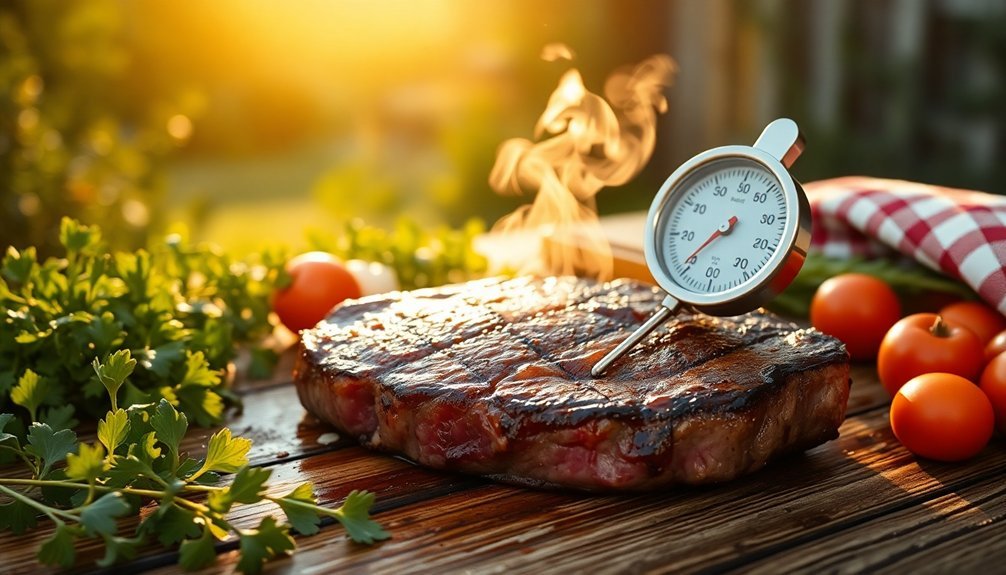
You'll need both direct and indirect heat zones in your grill for ideal temperature control, with the direct zone reaching higher temperatures for quick-cooking items like steaks and the indirect zone providing gentler heat for larger cuts.
Your success depends on maintaining proper food safety temperatures, including 165°F for poultry and 145°F for steaks, while actively monitoring these zones with a calibrated thermometer.
When mapping your cooking zones, remember to keep cold storage areas separate and maintain proper food holding temperatures below 40°F to prevent bacterial growth.
Heat Zones For Success
Mastering different heat zones on your outdoor grill can transform your cooking from basic to exceptional.
You'll need to understand three key zones: direct heat for searing meats and creating grill marks, indirect heat for slower cooking larger cuts, and cool zones for temperature control and food safety.
To map your grill's heat spots, try the bread test. Simply lay white bread slices across the grate and observe how they brown. This'll help you identify hot spots without special equipment.
Once you've mapped these zones, you can effectively use two-zone cooking, giving you the flexibility to handle different cuts and cooking preferences simultaneously.
Don't forget to use a thermometer to monitor internal temperatures and guarantee food safety while maximizing your grill's heat zones.
Cold Storage Safety Map
Proper temperature mapping of cold storage areas is essential for outdoor meal safety.
You'll need to maintain cold foods at 40°F or below using coolers with ice packs or frozen gel packs. Keep your beverages and perishables in separate coolers to minimize temperature fluctuations when accessing drinks.
Monitor your cooler temperatures with an appliance thermometer and document TCS food readings during storage and serving.
Don't let foods linger in the danger zone (40°F-140°F) for more than two hours, or one hour if it's above 90°F outside. Use ice baths to rapidly cool foods to 70°F within two hours and 41°F within four hours.
Pack your foods while they're still frozen, and label everything with storage dates.
Remember to keep coolers out of direct sunlight and minimize how often you open them.
Temperature Recording Methods
When cooking outdoors, accurate temperature monitoring can mean the difference between a perfectly cooked meal and an undercooked hazard. You'll find several reliable methods to check temperatures while grilling.
The hand test offers a quick assessment: hold your palm 3 inches above the grill and time how long you can maintain that position.
For more precision, use a surface thermometer placed directly on the grates, taking readings from multiple zones after a 5-minute heat-up.
Instant-read thermometers give you quick results when inserted into the thickest part of your meat, while probe thermometers offer continuous monitoring.
If you're tech-savvy, wireless probe thermometers let you track temperatures through your smartphone, with programmable alerts that'll notify you when your food reaches the perfect doneness.
Heat Retention Time Guidelines
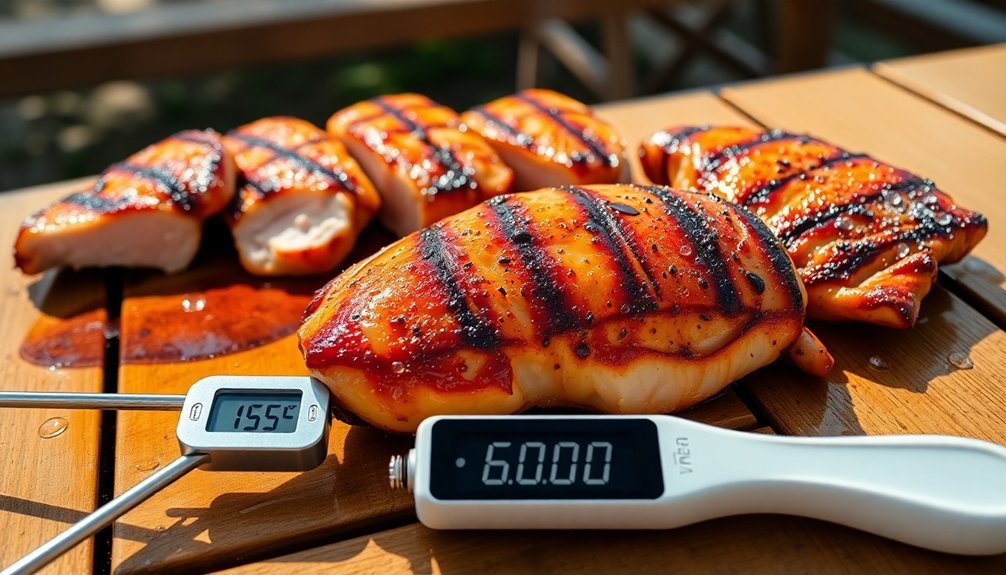
Understanding heat retention times helps you maintain consistent temperatures throughout your outdoor cooking session.
You'll need to master different heat ranges to achieve the perfect results for various dishes. Each range serves specific cooking purposes and requires distinct maintenance approaches.
- High heat (450°F-650°F) won't last long but it's perfect for quick-cooking items like tuna steaks, requiring just 2-3 seconds in your hand test.
- Medium-high heat (375°F-450°F) sustains for 10-15 minutes, ideal for burgers and veggies.
- Medium heat (325°F-375°F) can last up to an hour with the lid on, making it great for indirect cooking of poultry.
- Low to medium-low heat (225°F-325°F) demands hourly charcoal changes but works wonders for slow-cooking tough cuts like briskets and ribs.
Frequently Asked Questions
How Do Different Altitudes Affect Outdoor Cooking Temperatures?
You'll need higher temperatures and longer cooking times at increased altitudes since water boils at lower temps. For every 1,000 feet up, you'll lose 1.8°F in boiling point, affecting your cooking.
Can Vacuum-Sealed Foods Stay Safe Longer in Warm Temperatures?
No, you shouldn't rely on vacuum-sealing to protect food in warm temperatures. All perishable foods must stay below 40°F to prevent bacterial growth. Even vacuum-sealed items can spoil quickly when kept above safe temperatures.
What Temperature Variations Occur Between Gas and Charcoal Grills?
You'll find gas grills max out around 550°F with steady control, while charcoal grills reach beyond 1200°F. Gas offers consistent, easily adjusted heat, but charcoal gives you higher peaks with more temperature fluctuation.
Does Wind Chill Factor Impact Food Temperature Maintenance Outdoors?
Yes, wind chill will make your food cool faster outdoors through increased convection. You'll notice quicker temperature drops, though food won't get colder than the actual air temperature. Using insulated containers helps maintain warmth.
How Do Different Cooler Materials Affect Temperature Retention Rates?
You'll find rotomolded coolers maintain temperatures longest due to their pressure-injected foam insulation. Styrofoam coolers offer decent short-term cooling but aren't as effective, while basic plastic coolers provide minimal temperature retention.
In Summary
You'll find outdoor meal success relies on your careful attention to temperature schedules. Track your morning setup temps, manage midday heat spikes, and maintain proper food safety checkpoints throughout service. Keep a close eye on sun position and weather changes, adjusting your cooking zones accordingly. Remember to document temperatures regularly and follow heat retention guidelines for consistently safe, well-prepared outdoor meals.

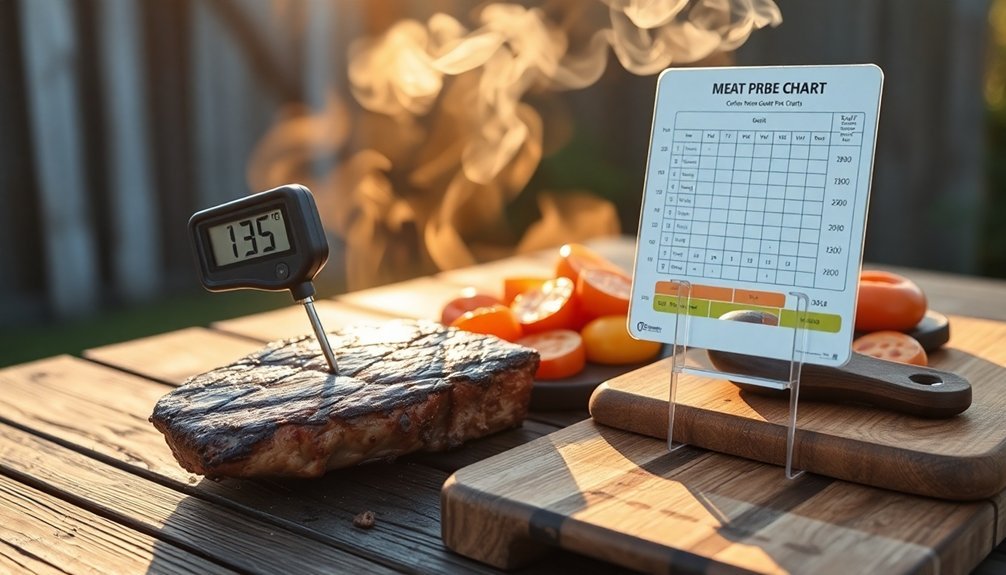



Leave a Reply